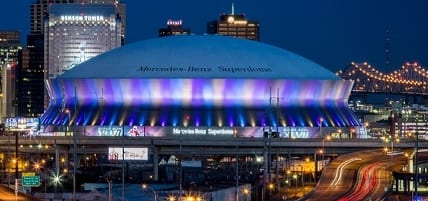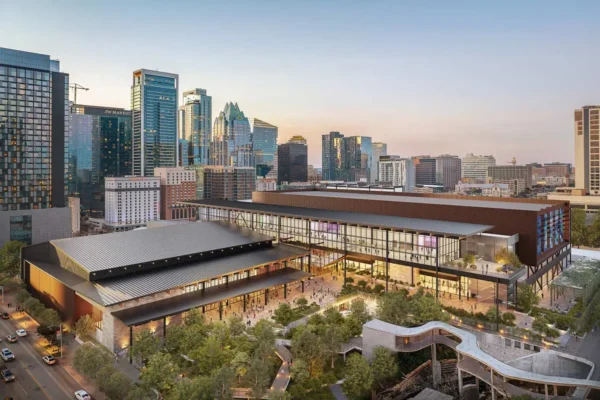As its 300th anniversary approaches, New Orleans is staying up to date thanks to $1.57 billion in capital improvements seen in many of the city’s venues.
 Changes are apparent as soon as visitors fly in to Louis Armstrong International Airport. A $300 million-dollar facelift of the airport included expansion of Concourse D, updated roadway signs and technology along with new lighting and furniture.
Changes are apparent as soon as visitors fly in to Louis Armstrong International Airport. A $300 million-dollar facelift of the airport included expansion of Concourse D, updated roadway signs and technology along with new lighting and furniture.
“Upgrades were made prior to the Super Bowl. The airport looks beautiful and user friendly,” said Kelly Schulz, vice president of communications, New Orleans Convention Visitors Bureau. “A new airport will be built on the site of the current airport in time for New Orleans’ tricentennial in 2018.”
Home of Super Bowl XLVII, held Feb. 3 in New Orleans, the 146,000 square-foot Mercedes-Benz Superdome underwent an $85 million renovation from January 2011 to June 2011. The million visitors attending the public and private trade and consumer shows the facility hosts five times a year can benefit from an expanded Plaza concourse, 3,100 new seats, three additional elevators for improved vertical transportation and more.
Making the Superdome stand out is its close proximity to New Orleans Arena and Champions Square; all three are SMG-managed venues. Featuring a 17,000 square-foot space for tradeshows and conventions, New Orleans Arena lies on 13 acres of land. The 121,000 square-foot Champions Square allows for outdoor events.
“The New Orleans Arena and Champions Square offer ancillary venues for exhibitors and attendees to have events in conjunction with their exhibit. This can offer a bit of variety for exhibitors – they are in the same complex, but the change of venue provides a different experience,” said Rebecca Ehlinger, sales and marketing manager, Mercedes-Benz Superdome.
 Attendees and exhibitors can also take advantage of the Superdome’s tax-free status. Visitors are not responsible for taxes on food and beverage or rentals. Rental charges are eliminated when exhibitors require tables, chairs and staging for tradeshows.
Attendees and exhibitors can also take advantage of the Superdome’s tax-free status. Visitors are not responsible for taxes on food and beverage or rentals. Rental charges are eliminated when exhibitors require tables, chairs and staging for tradeshows.
Providing the biggest meeting and tradeshow destination in New Orleans and the sixth largest in the nation, the 1.1 million square-foot Ernest N. Morial Convention Center (MCCNO) completed a $52 million expansion in January. This included a large outdoor pedestrian plaza and a 60,000 square-foot ballroom containing an energy-efficient lighting system.
“The expansion gave attendees and exhibitors more options to host their meetings by delivering a hotel-like experience,” said Tim Hemphill, director of sales and marketing, Ernest N. Morial Convention Center. “The ballroom has features you would find in a hotel ballroom, but it still retains exhibit hall features.”
MCCNO also includes 140 meeting rooms, another ballroom and a 4,000-seat auditorium.
Out of the 100 exhibitions MCCNO hosts each year, two of those shows are its own. The convention center secured the rights to The International Disaster Conference and Expo, which addresses disaster mitigation, and The Farm to Table International Symposium, which explores the cultivation, distribution and consumption of locally or globally grown food and beverages.
“Unlike in Europe, it’s unique for a convention center to own a show in the U.S. It is a matter of survival. Opportunities for generating revenue for facilities of this size are diminishing,” said Hemphill. “Our mission is to stimulate the economy, and it doesn’t conflict with our regular paying customers.”
The millions of people visiting the venue each year can also take advantage of MCCNO’s technology upgrades.
“We have the largest Internet fiber back bones. Cell phone carriers have upgraded access points within the building because we hosted Super Bowl events and a wireless show,” explained Hemphill.
In preparation for an event some New Orleans residents may consider bigger than the Super Bowl – the 300th anniversary of New Orleans – MCCNO envisioned a redevelopment plan for the properties surrounding it.
“There is movement to get ready for the anniversary, but the plan is not designed or fully funded yet. Hopefully, developers of property can put in hotels, restaurants and more,” said Hemphill.
According to convention officials, MCCNO envisions a boulevard re-imagined as a linear park, a people mover going from Canal St. to a power plant along with retail, entertainment, residential and lodging components.
The capital improvements in New Orleans also meant million-dollar hotel renovations, upgraded street cars and streets as well as millions, or billions in some cases, invested into the Bio District, which is focused on the development of the city’s biosciences industry.






























